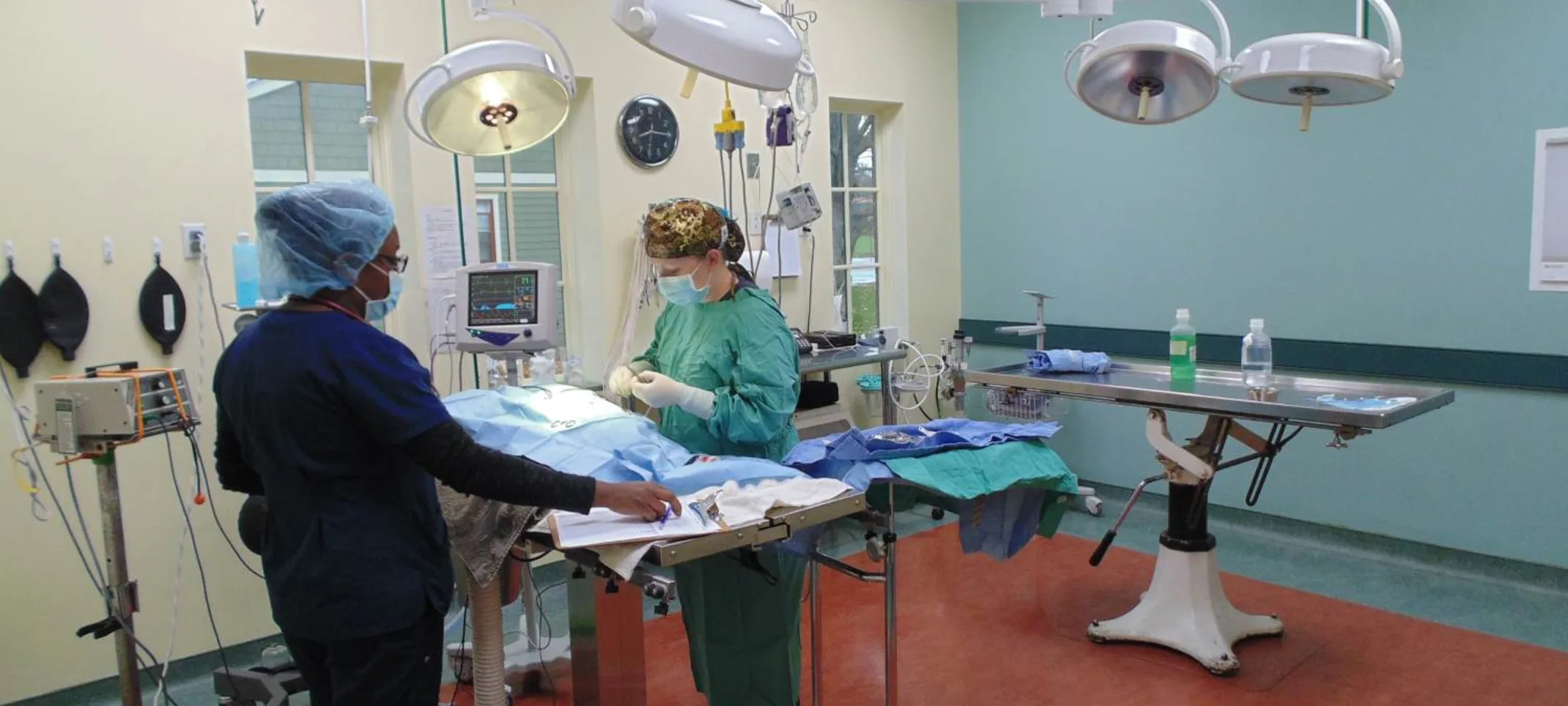Princeton Animal Hospital & Carnegie Cat Clinic
Surgery For Your Cat
Anesthetic procedures can be concerning, however at CCC, your cat will take every precaution to ensure your pet's safety, including blood work, radiographs and examinations.

Pre Anesthetic Requirements
Current Blood Work: It is required that all anesthesia patients have current blood work before any procedure. This typically includes a CBC, Chemistry Screen, with T4 and Urine (T4 and Urine are age and physiology based). A CBC measures different parameters of the red and white blood cells and can indicate problems such as anemia, inflammation, and infection. The Chemistry panel acts as a window into the functionality of many vital organs such as kidneys, liver, and pancreas to name a few. Thyroid and urine testing usually completes the profiles for older animals but may be indicated for some younger patients. Certain abnormalities in the above diagnostics could affect anesthetic protocol, anesthetic risk, and recovery of your pet. For most pets under the age of 7, the blood work is good for up to 1 year. For certain breeds or clinical conditions, more recent blood work may be required such as every 3-6 months. Most patients over 7 are required to have recent labs within the past 3-6 months.
Current Chest Radiographs: This is required for any patient over the age of 7 (maybe younger for certain breeds). The radiographs are taken to ensure both the heart and lungs appear to be in good working condition. We are focusing on any abnormalities that may put your pet at risk during anesthesia.
Additional Recommendations: Unfortunately, there are cases where an abnormality appears on either blood work or radiographs that require additional diagnostics. These abnormalities might require a simple recheck of a diagnostic prior to the surgery or maybe concerning enough to delay the procedure and sometimes even cancel the surgical procedure altogether. These recommendations would be discussed with you by the attending doctors.
Pre-Anesthetic Examination: All surgical candidates receive a pre-anesthetic examination the day of their procedure. The physical examination is completed focusing on the circulatory and respiratory systems. A thorough chart and history review is done to ensure any additional recommendations made have been followed through. A Pre-Anesthetic Risk Assessment* is assigned to the patient and a customized Emergency Drug table is completed based off the blood work, radiographs, physical exam, and risk assessment (age, breed, and history are key components). Following all this and based on the above information, a customized pre-anesthetic medication is given to help calm, relax, and prevent pain in each patient. This is key to a smooth anesthetic induction and post-operative recovery.
*American Society of Anesthesiologists (ASA) Physical Status Scale for Pre-Anesthetic Case Certification.
Induction of Anesthesia
The induction of anesthesia starts with placing an Intravenous catheter in every patient under any type of anesthesia. This catheter gives the surgical team direct access to the patient's vasculature for induction agents, fluids, and emergency drugs. The induction agents used are individualized for each patient based on breed, age, physical exam, and risk assessment. These are given to induce a patient into anesthesia before placing the patient on inhalant gas anesthesia. After the induction agents are administered, the patient has an endo-tracheal tube placed. This procedure provides a consistent open airway for patients throughout the surgery and is removed during the recovery of each patient. After the endo-tracheal tube is placed, the patient is started on inhalant gas anesthesia and then prepped for the surgical procedure. Prepping would include shaving the site and applications of antimicrobial agents to the area.
General Anesthesia: All animals placed under general anesthesia are administered Isoflourine as the inhalant agent. This extremely safe inhalant gas is readily used in human medicine as well. It is simply inhaled and exhaled and once the animal had been removed from the source, he or she will begin to recover. This particular agent has been noted to have little to no "hangover" effect which can be seen in other anesthetic agents and is the most widely used inhalant anesthetic. All surgical procedures are completed under strict aseptic protocol. Each patient receives new and sterile equipment. This equipment goes through a multi-stage process of cleaning and sterilization: the first is a hand cleaning with a special soap designed for our the instruments; next the equipment is placed into an ultrasonic cleaner that vibrates any additional debris away from the instruments; and finally after another hand cleaning, it is autoclaved at 275 degrees Fahrenheit to sterilize the whole surgical pack.
Monitoring: We always have at least one highly trained technician monitoring your pet while under anesthesia. The technician relays the vital data to the surgeon every 30 – 60 seconds. Throughout the procedure, intravenous fluids are given to support the patient's blood pressure, organ perfusion, and to keep the animal hydrated. A Patient Advisor Monitor is used to follow vital functions while our patients are under anesthesia. This monitor measures heart rate, ECG Pulse Ox (how well the tissue is oxygenated), blood pressure, respiration rate, Co2 levels (the carbon dioxide levels, which evaluate the efficiency and effectiveness of breathing), and temperature (temperature changes significantly affect the metabolism of anesthesia as well as organ function while under anesthesia, especially the heart). During anesthesia, the patient's ability to regulate his or her own body temperature is compromised. To combat this change, all patients are also thermal regulated using several sophisticated machines. We supply these patients with Gay-Mar thermal warm water blankets, Bair-Hugger Warm Air support, intravenous fluid line warmers, and heated tables. The technician keeps an accurate and detailed log of all of the above parameters throughout the surgical procedure. This is added to the patient's file for future reference and review.
Recovery
A patient's recovery begins with the pre-anesthetic protocols created for each pet. It follows with additional medications given during the procedure and finalizes with the patient waking up from anesthesia. We continue to monitor each patient throughout the recovery until he or she is up and moving. We support each patient with a comfortable bed to recover on and supplement him or her with thermal therapy as we did in the surgical procedure. Owners are typically called during the recovery period with an update.
Discharge: All discharges are scheduled by the technicians. This appointment is usually scheduled when the technician calls during your pet's recovery period. Each patient will be discharged with detailed "Go Home Instructions" outlining the procedure that was performed and the needed follow up care. These Go Home Instructions will be reviewed with you by one of our technicians. When the technician calls to schedule this release it is a good time to review any additional concerns or questions you may have. Since the doctors can often be tied up at the release appointment time this is a good time to get questions answered that only the doctor can answer.
Follow-up Care: Every anesthetic patient has some sort of follow-up care that should be completed. The recovery of your pets is a shared responsibility between the hospital and owner. Our responsibility is to supply you with as much education, information, and medications as needed to provide your pet with a smooth recovery. We will support you throughout this process with advice, coaching, and follow-up visits as necessary. We will call you to check up on our anesthetic patients and will continue to do so until we are both satisfied that everything is going well and the patient is on his or her way to recovery. Your job is to follow our instructions and inform us of any questions or concerns you may have. We have staff in the building 24 hours a day; 7 days a week so please call us with any concerns at any time. A large percentage of post anesthetic complications (which are rare) can be attributed to owner non-compliance to our instructions. It is important to take these recommendations seriously. Please call us if you have any concerns or difficulties.
Surgical Schedule: Our core values at Princeton Animal Hospital and the Carnegie Cat Clinic are to be available, dependable, and reliable to our clients' and patients' needs. With this in mind, we scrutinize our surgical schedule multiple times a day to ensure that we are not exceeding our hospital's capacity to service our patients responsibly. This also allows the ability to service our clients in surgical emergencies or adjust our schedule to meet the needs of a pet in discomfort while maintaining our surgical protocols and standards. Some non-emergency surgical procedures cannot always be "fit-in" for this reason. We hope you understand.
We appreciate your support and thank you for considering using Princeton Animal Hospital and the Carnegie Cat Clinic as your pet's anesthetic choice. We understand that no one likes to anesthetize their pet, but we hope to ease any concerns you may have by giving a brief description of the surgical protocols we follow at our hospital. Feel free to compare our protocols against other hospitals. We believe that you will find that we adhere to the highest anesthetic protocols in the veterinary industry! If you would like to take a tour of our hospital, please let us know. If you have any questions at all, please do not hesitate to ask. We are more than happy to discuss any questions or concerns with you.
Common Surgical Procedures Offered: Ovariohysterectomy (feline spay), castrations (male neuter), teeth cleaning (ultrasonic scaling and polishing, periodontal and fluoride treatments), oral surgery, dental extractions, tumor removals, exploratory, bladder surgery, eyelid surgery, perineal uresthrostomy, dewclaw removal (dog), cruciate ligament repairs, fracture repairs, femoral head resection and more advanced orthopedic procedures.
